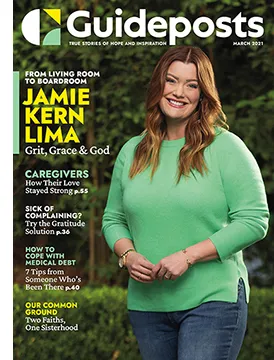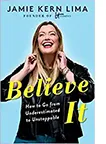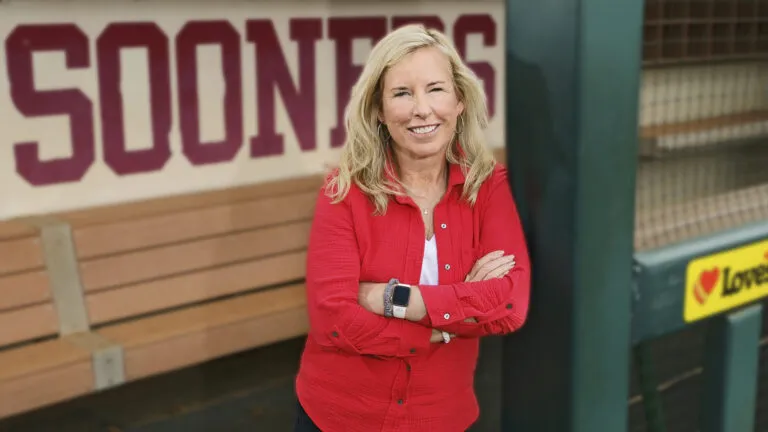We’d finally gotten it. A face-to-face meeting with the head buyer at Sephora. After hearing no from every major retailer in the country and, maybe the most painful of all, from a potential investor who told me, “I just don’t think women will buy makeup from someone who looks like you, you know, with your body and weight,” this Sephora meeting felt like our big chance. To convince Sephora, with more than 200 stores, that we had the perfect product line for them. IT Cosmetics—IT for Innovative Technology.
My husband, Paulo, was my business partner, and we’d prepared like crazy for this meeting. Pulling snapshots of “before” and “after” photos of women who’d used our products, pictures they’d posted on our website. Putting together a PowerPoint presentation, packing up samples. I tore apart my closet for the cutest outfit I could find—fashion being the last thing on my mind after working 24/7 in my sweatpants at home.

issue of Guideposts
I flew to San Francisco and walked into the Sephora offices feeling as if it were the cool kids’ club and I had to prove myself worthy. While most of their team was kind and supportive, the head buyer looked me up and down. Then she nodded for me to start my pitch. After 15 minutes, she cut me off.
“If women were excited about this product, I’d be hearing about it, and I’m not,” she said. Another no that felt so deflating, just like the one from the potential investor and many others.
I took the elevator down, leaned against a wall around the corner and burst into tears. Then I pulled myself together and called Paulo.
“We still have QVC to approach,” he consoled me. I wasn’t very hopeful at that moment.
What I looked like. My skin, my body. That was one of the reasons we started IT. I was fed up with how the beauty industry put images out there, airbrushed and overly Photoshopped, a mirage that played on our insecurities. A standard that was false and unattainable for women like me.
I’d learned that fact the hard way. In my late twenties, I’d been a TV journalist, anchoring the weekend morning news in Portland, Oregon, making a living on camera.
Then I developed an incurable skin condition called rosacea. It showed up on my face—big red patches, sometimes bumpy or sandpaper-like. Total strangers would stop me in the supermarket and ask if I had a sunburn or was sick. On the air, in the middle of a broadcast, I’d hear my producer say in my earpiece, “Jamie, can we do something about your skin during the next commercial break?”
I spent nearly all my paycheck on every type of foundation makeup I could find, getting free samples when I couldn’t afford anything more. Nothing helped. Or the makeup would be so thick, it made me look as if I were wearing a mask, cracked and caked in my smile lines. Being on camera only made it worse. I saw my career slipping away.
I was desperate when the vision came to me—a God moment, if you will. In moments of desperation, we sometimes hear God the clearest, and I heard this message loud and clear: Create makeup that was good for your skin, worked on all skin types and tones, and gave you what you needed but didn’t look as if you were wearing a mask. More important, I’d use women of all ages, shapes, sizes and skin tones to promote it. No false idols.
I knew a bit about running a business, at least on paper. After putting myself through Washington State—bagging groceries at Safeway, waiting tables at Denny’s—I’d gone to business school in New York City. That’s where I met Paulo in a statistics class. We fell in love studying data analysis together. Romantic? You bet. We’re both nerds at heart.
We were living in Portland and had been dating for five years when he proposed. I said I wasn’t ready yet. Which was true. Was I ready to make Paulo the most important thing in my life after God? Could I do that? I wanted to be absolutely sure because, if I couldn’t do that for Paulo, I couldn’t imagine ever doing it for anyone else.
A week later, he proposed again. “I’ll never love anyone more than I love you, Jamie,” he said. I prayed and prayed until I knew I had to say yes to Paulo. It was God’s will for me. We got married and, on our honeymoon flight, wrote up the business plan for IT Cosmetics. Soul mates and business partners. We quit our jobs and turned our living room into our office.
First of all, we needed to find the right manufacturer—we weren’t going to mix this stuff up in our kitchen sink. But after cold-calling one beauty company after another, people hanging up on me left and right, I was flummoxed. Who they used was their best-kept secret. Finally, we got the name of a good manufacturer and started working with them, developing samples.
I tested the products on myself, wearing them all day long. I’d walk around making faces, seeing if the makeup cracked. I even tried out an eyebrow pencil on Paulo’s thick brows. (He’ll kill me for saying this.) And I tested on every friend and family member I had. We needed to know that these products would work on real people like us.
I loved our CC Cream, a color-correcting product that fully covered my rosacea and contained moisturizers and sunblock. Then there was Bye Bye Under Eye, which did just what it said. As I worked hundred-hour weeks, you can imagine how much I needed that!
Our first attempts at getting our products into retail went nowhere. All we got were nos. Okay, if retailers wouldn’t sell our stuff, we would sell it ourselves. Paulo pored over a big yellow book, HTML for Dummies, and built our first website.
Every day, I logged on and checked to see how we were doing. Nothing. No orders. Day after day. “The website’s not working,” I complained to Paulo. A couple days later, we finally got a buyer. It felt like Christmas morning. “Isn’t this great?” I said.
Paulo looked at me sheepishly. “That was me,” he said. “I placed the order just to prove to you that the website’s not broken.”
Discouraged and confused, I’d ask God if he really wanted this for me. Doubt would crowd in. I’d pray about it and feel God telling me, “Keep going. Believe in IT.” So we did. One modest success was getting onto the Shopping Channel in Canada. Those sales kept us going.
The best thing was the word of mouth. Women would post their “before” and “after” pictures on the site. Seeing real women getting real results was inspiring. I couldn’t let those loyal customers down. That’s why the meeting with that potential investor loomed so large. And why the rejection was so painful. Now Sephora had turned me down too.
I kept replaying the investor’s words in my head: No one is going to buy makeup from someone who looks like you, you know, with your body and your weight. That was so wrongheaded. Why pretend to be somebody I wasn’t? I’d struggled my whole life to love myself as God loved me in a culture that burdened so many women with a false standard of beauty.
QVC, the largest shopping channel in the country, was our last hope. I emailed, called, messaged, sent samples and finally got a call back from the head of beauty but not the call I wanted. We weren’t “the right fit for QVC or the QVC customer.” I was crushed. Worse, there was nowhere else we could go with IT. We’d exhausted every avenue.
But we hadn’t exhausted God. I was at a cosmetics convention where hundreds of products were being demonstrated and displayed. Scores of people stopped by. As always, they loved our products. Out of the corner of my eye, I spotted the QVC booth and recognized a QVC host.
I was about to ask God if I should go over when she strolled up to our booth. “I think our QVC customers would really like this concealer,” she said, holding up Bye Bye Under Eye.
Tears welled up in my own eyes.
“Now, sugar,” she said, “I don’t have any say at all if they take a product or not, but I want you to know I just told the QVC buyer about your product!” Paulo and I flew to the QVC headquarters outside Philadelphia and gave a presentation. I braced myself for rejection. I was so used to hearing no instead of yes. Instead, I heard, “Great, Jamie. We’d like to give you a shot.”
I’d have all of 10 minutes of airtime to sell some 6,000 units of our product. That was the deal with QVC. Six thousand in 10 minutes or you don’t come back! Not only sell them but have them ready to be shipped. We reached out to banks, trying to get a loan so that we could pay for all that inventory. Only one small bank would give us a loan. By broadcast time, we were down to our last $1,000. Not just in our business account but our personal account.
If I couldn’t succeed in those 10 minutes, we’d be finished. Paulo and I were risking everything on 10 minutes of airtime. So much was riding on what I said and did.
I went on air, my arms shaking, my face red. “Take a deep breath. You’re doing great,” said the QVC host, squeezing my arm. I’d decided not to wear full makeup—as I did as a news anchor—but to expose my true self and my bright red rosacea on my skin on national television. And show how our products worked.
The clock ticked. I put everything on the line, my whole heart and soul. I could hear a flurry of activity. Were those sales? Yes! The numbers kept rising. The “Sold Out!” sign went up on the screen just before time was up. I was weak with relief and gratitude.
I’d love to say the rest was easy, but of course it was a lot more work. The difference this time: The nos turned into yeses. I did countless more appearances at QVC, and we became their number one beauty brand. The huge retailers, all those people who didn’t return my calls, came back. Including Sephora.
Now CEO of a big successful company, I was not going to give up our vision. We were there for real women, with models of every age, skin tone and size. Beauty inside and out, as God intends.
In 2016, we sold IT to L’Oréal for $1.2 billion and I became the first female CEO of a L’Oréal brand in its more than 100-year history. A lot of things—and people—went into our success, but from those early days of just Paulo and me working out of our living room to today, I always knew a higher power held our dreams.
Take that QVC host, the one who’d approached us at the convention. I called her many years later, when we had become one of the largest makeup companies in the country. “Oh, honey, I love your concealer,” she said. “I wear it every day, but that’s not why I went up to you that day.”
And then she said, “God told me, you know, God spoke to me to go help that girl. Just like that. And so I did. I just listened.”
Which is the greatest lesson I take away from this incredible journey: Even when everyone is saying no, God is saying yes. Just listen.

For more inspiring stories, subscribe to Guideposts magazine.





